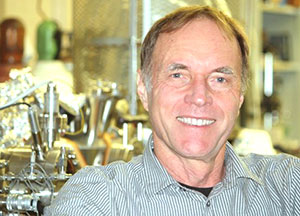
Nanoscale science has been the basis for a worldwide surge in nanotechnology, generating many advances and inventions. However, technology is heading towards even smaller and efficient devices, which rely on smaller designs and structures. Klaus Sattler, professor at the University of Hawaiʻi at Mānoa Department of Physics and Astronomy, has published a new book entitled Fundamentals of Picoscience, the first-ever book to address the instrumentation and experiments emerging at the picometer scale.
Sattler’s previous publication, the 7-volume Handbook of Nanophysics has become an important source for scientists and engineers worldwide in the field of nanotechnology, and he predicts that the Fundamentals of Picoscience will prove to be a breakthrough publication of similar influence in the emerging field of picotechnology.
One picometer is the length of a trillionth of a meter. Compared to a human cell of typically ten microns, a picometer is roughly ten million times smaller. As editor, Sattler conducted the collaborative effort of 72 authors from 22 countries.
The 37-chapter book describes experimental picometer-scale techniques, including electron and neutron holographic microscopy, spin-sensitive atomic-scale imaging, attosecond electron orbital mapping, adaptive holographic interferometry and atomic-resolution transmission electron microscopy. Fascinating opportunities for nanomedicine, biomolecular engineering and proteomics are described in the book. It details atomic-scale structure determination of proteins and individual peptides, crucial for understanding enzyme functioning.
International scientists and researchers who are leaders in the field present the materials and methods used at the picoscale and address key challenges in developing new instrumentation and techniques to visualize and measure structures at this sub-nanometer level.
The book also explores the future of picoelectronic devices, such as single-molecule electronics, single-atom transistors for light and picoscale optical computers.The book aims to help the reader understand picoscience as an extension of nanoscience as well as offer practical advice on determining which experimental technique to use in their own research and connect basic studies to the development of next-generation picoelectronic devices.
While the current efforts in picoscience probably will not be utilized for another 10 to 20 years, scientists like Sattler are confident that we will one day have picomotors, picobatteries, picoelectronics, and picomedicine. He is certain Fundamentals of Picoscience will be a huge factor in facilitating such developments with its focus on the basic concepts of physics and engineering required for future picotechnology.
More on Klaus Sattler

Sattler has been working at UH Mānoa since 1988. His research group obtained the first atomic-scale images of carbon nanotubes and produced the first carbon nanocones.
His current work focuses on nanodiamonds, graphene quantum dots and solar photocatalysis with nanoparticles for the purification of water.
Sattler has been a recipient of the German Physical Society’s Walter Schottky Prize. He received a PhD from the Swiss Federal Institute of Technology.

